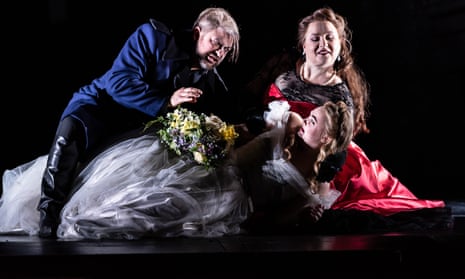It is only four years since the director David Alden placed Wagner’s Lohengrin firmly inside an oppressive and febrile wartime setting for the Royal Opera. Today, Alden’s approach, now in the hands of Peter Relton in this first revival, feels disturbingly prescient in light of current events in Europe; the opera’s setting in a divided society threatened by war from the east has shed its historical trappings and instead become unexpectedly contemporary.
Not everything works entirely persuasively in Alden’s visceral presentation of Lohengrin’s Brabant as a quasi-fascist society, its public square dominated by an Albert Speer-style swan monument. Not least Lohengrin’s own music, especially in act three, which shows him to be anything but a fascist leader, and the militarism and red-and-black flag-waving of the production feels overdone as a consequence.

But the pervading darkness of Adam Silverman’s lighting and the expressionist angularity of Paul Steinberg’s claustrophobic sets make this an unusually powerful revival. The sole concession to the romanticism that made Lohengrin so popular in the early 20th century is a reproduction on the bridal chamber wall of a mural of the swan knight from one of King Ludwig II of Bavaria’s castles. The message that the old Lohengrin is played out was clear.

Musically, the revival is built on extremely strong foundations. Jakub Hrůša has an unerring sense of the work’s structure, never trying to force the score. The Royal Opera orchestra’s playing in the great scene between Lohengrin’s two enemies, Telramund and Ortrud, in act two was gripping. But in this most choral of all Wagner’s operas it was a night on which the Royal Opera chorus seized a chance to shine. They were magnificent.
As Lohengrin, Brandon Jovanovich has the presence and heroic tenor ring that much of the score requires, although in some of the more intimate passages of act three there were signs of vocal pressure. Jennifer Davis repeated the expressive and well-judged Elsa that made such a mark in 2018. Craig Colclough stormed to fine effect as the hapless Telramund, and Gábor Bretz brought vocal nobility to King Heinrich. As so often in Lohengrin, however, it was Ortrud, here sung with unremitting fire by Anna Smirnova, who seized the attention. The malevolent pagan outsider from the north seems to have wandered into the opera from the as-yet unwritten Ring cycle, and Smirnova grabbed the opportunity with both hands.

Comments (…)
Sign in or create your Guardian account to join the discussion